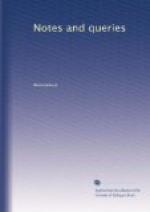But a discovery was made in 1827 of the remains of a body in the centre of the spot where the shrine stood, with various relics of a very early period and it was asserted to be the body of St. Cuthbert. This, however, has not been universally assented to, and Mr. Akerman, in his Archaeological Index, has—
“The object commonly called St. Cuthbert’s Cross” (though the designation has been questioned), “found with human remains and other relics of the Anglo-Saxon period, in the Cathedral of Durham in 1827.”—p. 144.
There does seem considerable discrepancy in the statements of the remains found in 1827 and the body deposited 1541.
I will conclude with asking, Is there any evidence to confirm the tradition of the Benedictines?
J.R.N.
Vavasour of Haslewood.—Bells in Churches.—It is currently reported in Yorkshire that three curious privileges belong to the chief of the ancient Roman Catholic family of Vavasour of Haslewood:
1. That he may ride on horseback into York Minster.
2. That he may specially call his house a castle.
3. That he may toll a bell in his chapel, notwithstanding any law prohibiting the use of bells in places of worship not in union with the Church of England.
Is there any foundation for this report; and what is the real story? Is there still a law against the use of bells as a summons to divine services except in churches?
A.G.
Alteration of Title-pages.—Among the advertisements in the last Quarterly and Edinburgh Reviews, is one which replies to certain criticisms on a work. One of these criticisms was a stricture upon its title. The author states that the reviewer had a presentation copy, and ought to have inquired into the title under which the book was sold to the public before he animaverted upon the connexion between the title and the work. It seems then that, in this instance, the author furnished the Reviews with a title-page differing from that of the body of his impression, and thinks he has a right to demand that the reviewers should suppose such a circumstance probable enough to make it imperative upon them to inquire what the real title was. Query, Is such a practice common? Can any of your readers produce another instance?




